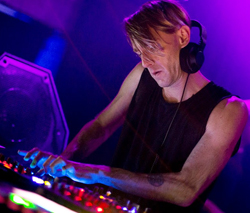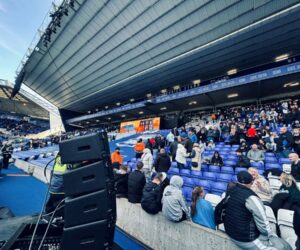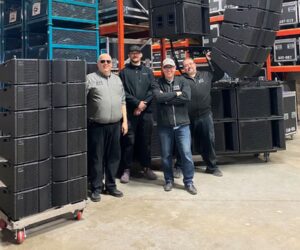Richie Hawtin’s recent tour of the US and Canada, an educational initiative created to inspire new generations of producers and performers of electronic music, was powered by a unique combination of Lab.gruppen and Lake processing.
Over 12 days and eight cities, the music technology tour touched down at colleges and hot spots in eight major markets across North America – from Boston’s Berklee College of Music to Montreal, Toronto, Seattle, San Francisco and Los Angeles.
During the day, events were staged in lecture theatres at colleges and universities, while at night the tour played in up to 5,000 capacity clubs such as the Palladium in Los Angeles, as well as in a number of 1,000 person rock and roll venues.
Ever the innovator, Hawtin is constantly pushing the frontiers of performance and technology.
He is well known for DJing techno sets making use of laptops and digital mixing equipment, and his current setup is no exception. His longtime audio tech Johannes Kraemer has designed a truly unique monitor rig that was inspired by a desire for the purest audio quality possible.
“On this tour the PA is different every time as we’re always using the house system, but Richie’s monitor setup is something special,” he explains.
“We have two versions of the monitor system. Most of the time in clubs we are using a pair of Funktion One PSM318 DJ monitors. We output straight from the digital desk, fitted with a My Dante option card, via Dante over Cat-5 straight into the two Lab.gruppen PLM20000Q amps that drive the monitors. In the larger scale events we use two L’Acoustics SB28 subs and two Arcs II per side.”
The system runs at 96kHz throughout, with only one A/D conversion and one D/A conversion taking place in the signal chain.
“The reason we chose the PLMs is that we’re big fans of 96kHz signal transmission and for the clarity of the signal chain – and Lab.gruppen totally delivers that. There are details you just don’t hear at 48kHz with the usual signal chains. The PLMs have plenty of power and great bass channels limiters, which suits Richie’s very dynamic style. I love the low latency on the desk side and the fact we can fire it with Dante.”
“There’s no EQ at all on the monitors,” says Kraemer, “and even the crossover between the double 18-inch subwoofers and the high bass is set to a 12 dB per octave slope as this gives more flexibility when increasing or decreasing the sub level because the acoustical crossover is only like the electrical crossover point when sub and high bass are equal. The subs are fed from a mono aux send on the desk.
“The monitor system takes only 15 minutes to set up each night, and the only adjustments we make is to increase or decrease the sub level depending on whether there is an open stage or a more closed DJ booth.”
When asked to describe the pristine quality of audio in the DJ booth, Kraemer comments: “Our DJ booth sound is a kind of a reference on the scene, and when other DJs know that they can play on our setup, they skip their riders.”
Kraemer has worked with Richie Hawtin for many years, for the first time in 2000 and then with a stronger collaboration from 2008 onwards. He learned his trade as an electrician in the highly disciplined environment of large-scale power plants, and became passionate about quality audio through working with rock and roll bands in his local area around Cologne.
He developed his concept for the current monitor setup as a result of the highly advanced digital technology available today. “I explained my ideas to Richie, and we experimented and rehearsed at length to improve the sound from the source.” He says.
According to Hawtin, “Electronic music is innately tied to the technology used to create it – as the tools evolve, so will the art.” His Lab.gruppen and Lake DJ monitor system is clearly no exception.
“Sound quality is the fundamental driving force,” says Kraemer. “Transient behavior is really good as we have no filters, and the sub frequencies are very defined. Richie often mixes two or three bass lines – this is not a sine wave thing anymore, it’s a really personal sound where you need precise control of the subs and bass.”




















